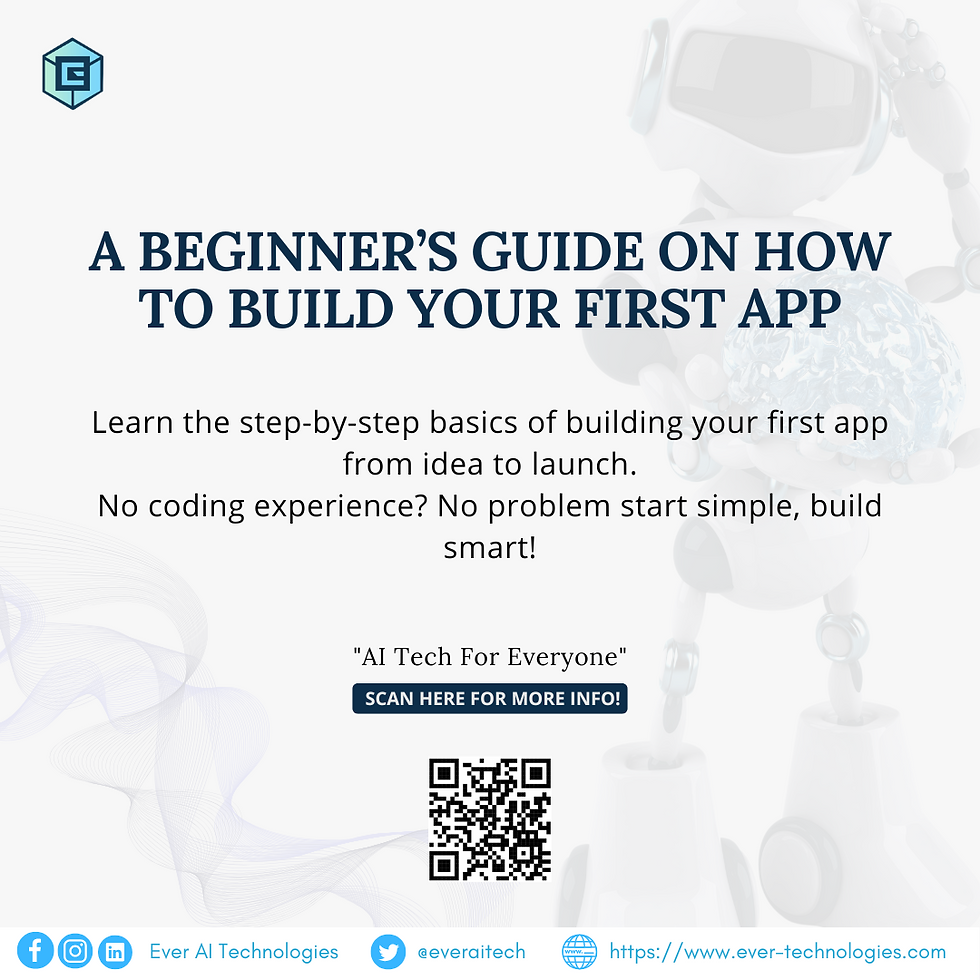A BEGINNER’S GUIDE ON HOW TO BUILD YOUR FIRST APP
- miza42
- Jun 23
- 3 min read
Updated: Jul 3

So You Want to Build an App? Here’s Where to Start.
In today’s digital age, having an idea for an app is just the beginning. Whether it's a productivity tool, a game, or the next big social platform, turning that idea into a real, working application can feel overwhelming, especially if you're just getting started. The good news? You don’t need to be a coding expert or a tech genius to build your first app. With the right guidance, tools, and a bit of curiosity, anyone can begin their app development journey.
In this beginner-friendly guide, we’ll walk you through the essential steps to plan, design, and build your very first app from concept to launch. Whether you're doing it for fun, learning, or to solve a real-world problem, this is your starting point.
Let’s break it down, step by step.
1. Workshop Your Idea & Strategy
Start with a focused brainstorming session, either solo, with friends, or in a formal workshop. Define:
What problem does your app address
Who your target users are
Key features or user journeys
Gather diverse input early; it enriches your concept and builds buy‑in.
2. Document Requirements
Transform your strategy into a Statement of Work (SoW). Include:
Core features
User stories (e.g., “As a user, I want X so I can Y”)
Technical and business expectations. This ensures everyone’s aligned before actual development begins
3. Design UX (Wireframes)
Sketch out each app screen and how users flow between them. Use tools like Figma or Balsamiq, or paper. The goal is clarity, not beauty: focus on layout and logic.
4. Design UI (Visual)
After wireframes:
Apply brand elements (logo, colours, fonts)
Craft polished screens that reflect your brand identity. This is when your app starts looking and feeling real.
5. Build a Prototype
Use clickable mockups (e.g., in Figma, InVision). This allows stakeholders and testers to:
Experience navigation flows
Identify usability flaws
Avoid expensive rework later
6. Develop the Back End
Create the server-side foundation:
Set up databases and cloud infrastructure
Build APIs and handle user authentication/data storage. Back-end development is essential for apps with accounts or shared data
7. Develop the Front End
Build the app’s user-facing side:
Native languages: Swift (iOS), Java/Kotlin (Android)
Cross-platform: React Native, Flutter. Ensure smooth interaction with your backend
8. Test Thoroughly
Continuously test features as you build:
Manual testing to spot UX and minor bugs
Automated testing for larger or mission-critical apps. Early and frequent testing is key to quality
9. Debug & Refine
Expect bugs—debug regularly:
Crash reports are handled immediately
Polish details like alignment, fonts, and labels. Each fix improves stability and user satisfaction
10. Deploy to Live Environment
Move from staging to production:
Finalize cloud/server configurations
Ensure SSL, scaling, and monitoring are set
Prepare release certificates (especially for iOS).
11. Release on App Stores
Publish your app:
Google Play: ~$20 USD one-time fee
Apple App Store: ~$100 USD/year Supply assets like icons, screenshots, and descriptions; then submit for review
12. Maintain and Iterate
Launch isn’t the finish line:
Analyze user feedback and metrics
Update features, fix new issues
Evolve UX/UI and performance based on real usage.
Or you can refer to a YouTube video for more details: https://youtu.be/jniJeamcIUU?feature=shared













Comments